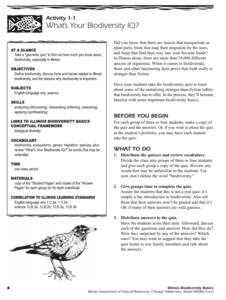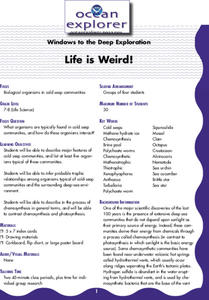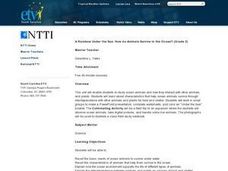Curated OER
The Brown Rice Bonus
Students investigate how brown rice can be incorporated into a daily healthy diet. They practice preparing and storing the rice in the most beneficial ways. Also goals are set to increase the consumption of it in the dose of twice a week.
Illinois Department of Natural Resources
Section One: What is Biodiversity?
Four intriguing and scientific activities invite learners to explore the natural resources of their town. The activities cover concepts such as genetic traits, organizing species in a taxonomy, the differences between different species...
Arizona-Sonora Desert Museum
Desert People and the Saguaro
The saguaro is the focus of an examination of the importance of this stately cactus to the indigenous people in the Sonoran Desert.
Curated OER
Caribbean Culture Day
Students are introduced to about Caribbean culture through the preparation and sampling of Caribbean food, as well as become familiar with Caribbean folk songs and poetry. They also experience blindness in order to form a deeper...
Curated OER
Needs versus Wants
Second graders explore the difference between needs and wants. They explore the three important things that people need to survive.
Curated OER
A Balanced Diet
High schoolers determine which healthy foods comprise a well balanced meal. Using a checklist, students classify foods as healthy or unhealthy. This lesson is intended for high schoolers acquiring English.
Curated OER
Starvation in the Ghettos
Students investigate how human beings survive under camp and ghetto life's extreme condition while understanding the USRDA requirements. They recognize the suffering and loss of life due to the lack of adequate nutrition.
Curated OER
Milk and Dairy, Day 1
Students review different types of milk products and their characteristics, demonstrate how to select and prepare milk and milk products, identify standard serving sizes, define terms associated with milk and milk products, and practice...
Curated OER
What are Hunger and Malnutrition and Who are the Hungry?: Food, Ethics, Global Cultures
High schoolers explain the consequences of hunger and malnutrition, to know the magnitude of hunger in the world today and to know who is hungry and malnourished in the world.
Curated OER
Life is Weird!
Students describe major features of cold seep communities, and list at least five organisms typical of these communities. They infer probable trophic relationships among organisms typical of cold-seep communities and the surrounding...
Curated OER
Farming in a Fishbowl: How Ethnic Groups in
Seventh graders research Chinese agricultural needs and practices. They conduct an experiment with aquaculture and germinated rice as they take measurements and apply the scientific method.
Curated OER
Outdoor Survival
Students are introduced to basic outdoor survival concepts. They identify the seven basic needs for survival. Students describe the symptoms and treatment for frostbite and hypothermia. They compare and contrast the value of different...
Curated OER
Fractions in Shapes
First graders explore fractions with manipulatives. In this fraction lesson, 1st graders use paper foods such as sandwiches and pizza in order to find halves, thirds, fourths, eighths, and more. This lesson is divided up into 3 tiers...
Curated OER
Ground Beef Experiment
Students identify what ground beef is and the difference in fat, flavor and moistness between the three types - regular, lean, and extra lean. Then, they conduct an experiment to compare the effect of pan frying
between three different...
Curated OER
Hunters/Gatherers
Students discuss the ways in which an environment is used to provide the basic necessities of life. In groups, they compare and contrast how different hunter and gatherer groups have used the environment to their advantage. They place...
Curated OER
Make Waves
Sixth graders discover, through exploration, the basic characteristics of waves. After a lecture/demo, 6th graders work in groups and participate in a series of labs where they investigate waves. Each group presents its findings to the...
Curated OER
Introduction To Insect & Spider Body Parts
Students inspect several different specimens of insects and spiders to determine characteristics that are similar and different between the two groups. They identify the basic body structure of spiders and insects and then predict where...
Curated OER
A Rainbow Under the Sea: How do Animals Survive in the Ocean?
Second graders read books, watch videos, complete worksheets and participate in class discussions about ocean animals. They, in groups, design PowerPoint presentations on selected marine animals.
Curated OER
Magnets, Electromagnets, and Motors
Students investigate the concepts of magnetism and its properties. They construct a magnet and test foods for iron content. Then students define the use of a motor and make their own electric motor while working in small groups. Then...
Curated OER
Free Enterprise -- Product Cost
High schoolers are introduced to the concept of free enterprise. In groups, they discuss the price of various food items and decide on which item to produce. They calculate the cost of producing the item and share their results with...
Curated OER
Growth and Changes in Plants
Students investigate the growth and changes in plants. They view a video and discuss the changes in plants. They work in small groups to demonstrate vocabulary words to the class. They visit a green house and take pictures of plants to...
Curated OER
Edible Soil
Students model the soils layers using Oreo's. In this lesson students use their favorite food items to create a model of soil layers. A discovery lesson from a youth camp is adapted for classroom modeling and discussion of soil...
Curated OER
Leavening
Students experiment with the various types of leavening agents and complete a muffin lab. They review the basics of lab management and safety procedures: sanitation, measuring, altering recipes, table setting and mealtime manners, basic...
Curated OER
Travel English For Restaurants
students will practice to develop the skills of the English Language that are necessary for successful dining experiences. The communication of English is a target skill for the second language learner. The simple activity of ordering in...























